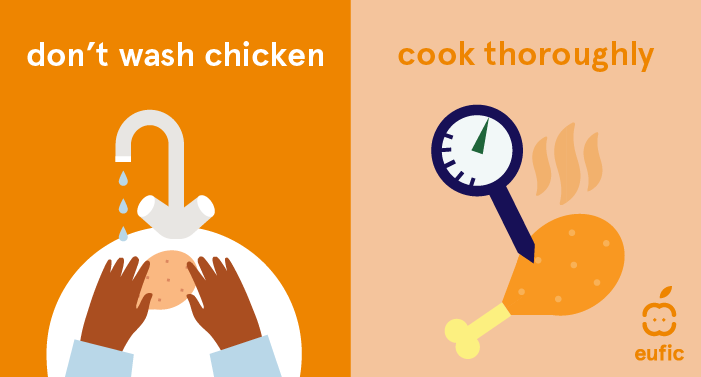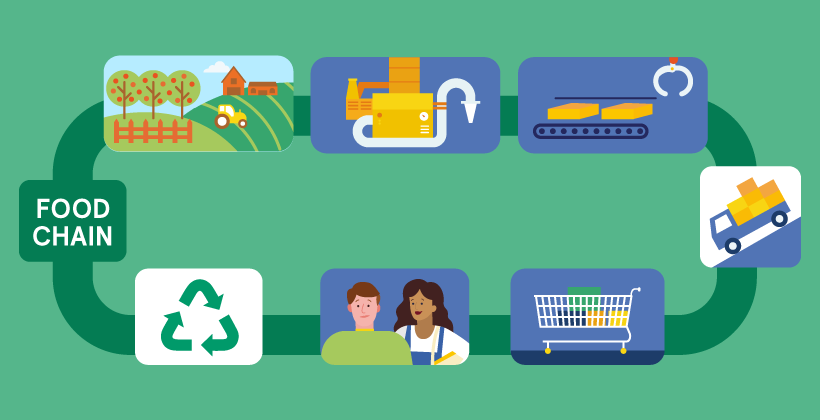How to prevent food poisoning: tips & tricks
Last Updated : 12 September 2021While Europe is the global region with the lowest estimated burden from food poisoning,1 hundreds of thousands of cases are reported in the European Union each year.2 Many people become ill from food prepared or stored incorrectly at home, but the good news is that many cases are mild and we can all keep ourselves safe from food poisoning by following some simple tips.
Food poisoning is caused by eating food contaminated with illness-causing pathogens. It is not contagious. Symptoms can range from mild to severe, depending on the cause, but commonly include:
- nausea
- vomiting
- diarrhea
- stomach cramps
- weakness
- loss of appetite
- fever
- aching muscles
- chills
In severe cases, food poisoning can lead to hospitalization or even death. If you are pregnant, you should pay extra attention to avoid food poisoning. Depending on the cause, food poisoning can last from a couple of hours up to several days. Three important causes of food poisoning are:3
- Bacteria and viruses: These can multiply in the body and make us sick. Microbes can take time to multiply to levels that cause symptoms so it may take several days for symptoms to appear.
- Parasites: Depending on the type of parasite, the onset of symptoms can vary, and some people may be unaware they have been infected.
- Toxins are produced by living organisms such as bacteria or fungi. Cooking kills bacteria but toxins remain in the food and can cause illness. The symptoms can appear just a few hours after eating contaminated food.
At home
In Europe, the majority of reported food poisoning outbreaks start at home with bacteria (such as Campylobacter and Salmonella) and viruses (such as norovirus) being common causes.2 Sticking to some basic food hygiene rules can prevent us from getting sick.

1.Keep clean 4,5
Our hands, kitchen utensils, and dishcloths all carry microorganisms. While not all microorganisms are dangerous, it is recommended to;
- Always wash your hands thoroughly with warm soapy water before handling food and repeat often during food preparation.
- Cover any cuts with waterproof bandages and do not prepare food for others if you are sick or have a skin infection
- Prepare and chop food on a clean surface and clean all utensils and surfaces thoroughly after use with hot water and detergent, or in the dishwasher.
- Wash dishcloths, tea towels, hand towels and aprons frequently at high temperatures.
2. Separate raw and cooked 4,6
Raw foods can contain invisible disease-causing microbes. These can be transferred to ready-to-eat foods by cross-contamination either directly (for example if raw meat comes into contact with cooked foods) or indirectly (for example by chopping salad vegetables with a knife that was previously used to chop raw meat).
- Keep raw and cooked foods separate to avoid harmful microbes from raw foods spreading to ready-to-eat foods
- Use different utensils/chopping boards for raw and cooked foods to prevent cross-contamination. It may help to dedicate different coloured chopping boards to fruit/vegetables, fish/seafood, meat/poultry or raw/cooked foods.
- Never wash raw chicken as the splashing water can spread bacteria around the kitchen.

3. Cook thoroughly 4,8
- Cooking food properly to kill microorganisms growing in uncooked or undercooked meats & shellfish, or unpasteurised dairy products.
- Cooking/heating foods to temperatures of at least 72°C for 2 minutes will kill most illness-causing microbes.
- Check temperatures using a cooking thermometer, inserted into the centre of the food, or the thickest part of the meat away from the bone.
- Whole cuts of beef (steaks, joints) or lamb (chops, joints) can be eaten rare or pink as they are unlikely to have harmful bacteria in the centre. The outer surface should be seared to kill bacteria.
- Ground meat/fish products (such as burgers, sausages or fishcakes) have a large surface area and are therefore more likely to be contaminated than whole cuts of meat. These foods should be cooked through to a core temperature of at least 72°C for 2 mins.
- For pork and poultry, there should be no pink meat left. If you don’t have a thermometer, pierce the thickest part with a fork or skewer; the juices should run clear, not pink.
- Reheat leftovers of pre-prepared foods thoroughly. Bring soups and stews to a boil for at least 2 minutes.
- It is also safe to eat leftover leafy greens like spinach as long as they are thoroughly reheated.
4. Keep food at safe temperature 4,7,8
Microorganisms can multiply quickly, make sure to slow down the process by storing below 5°C or heating over 60°C.
- Keep the fridge below 5°C and check regularly using a refrigerator thermometer.
- Cool and place cooked foods and leftovers in the fridge within 2 hours.
- Serve food hot over 60°C.
- Thaw frozen food completely before cooking, ideally in a container in the fridge overnight.
- Keep leftovers in the fridge for maximum of 2 to 3 days.
5. Use safe water and raw materials 4
- Avoid contamination from dangerous microorganisms and chemicals. Select your water and raw materials carefully.
- Choose fresh foods, avoid food that is rotting.
- Do not use food beyond ‘use by’ date.
- Wash fresh vegetables and fruit well with clean water before use to remove potential contaminants from the surface.
For more tips on how to cool and store leftovers see Safe food storage at home.
Some common foodborne illnesses and their symptoms
|
Pathogen |
Type of pathogen |
Symptoms |
Commonly associated foods |
|
Campylobacter (causes Campylobacteriosis) |
Bacteria |
Diarrhoea, abdominal pain, fever, headache, nausea, vomiting. Symptoms typically start after 2-5 days and last for 3-6 days. |
Raw milk and dairy products, raw/undercooked poultry9 |
|
Salmonella (causes Salmonellosis) |
Bacteria |
Diarrhoea, nausea, vomiting, fever, abdominal pain. Symptoms usually occur after 6-72 hours and last for 2-7 days. Rarely, it can lead to severe dehydration that can life-threatening, especially in children or the elderly. |
|
|
Yersinia (causes yersiniosis) |
Bacteria |
Fever, abdominal pain, diarrhea. |
Undercooked meat2 |
|
Listeria (causes Listeriosis) |
Bacteria |
Symptoms can range from mild flu-like symptoms, nausea, vomiting and diarrhoea, to serious complications such as meningitis or other potentially life-threatening conditions. |
Ready-to-eat foods such as smoked fish, cured meats and soft cheeses12 |
|
Certain strains of E. Coli (e.g. EHEC, STEC, VTEC) |
Bacteria |
Abdominal cramps, diarrhoea, fever, vomiting. Symptoms typically start after 3-8 days and last for up to 10 days. In rare cases, it can cause haemolytic uraemic syndrome (HUS), which can cause kidney failure. |
Unpasteurised milk and cheese, undercooked meat, raw salad vegetables (e.g.sprouts, spinach and lettuce)13 |
|
Norovirus |
Virus |
Diarrhoea, vomiting, abdominal pain |
Uncooked shellfish, raw fruits and vegetables, but any food can become contaminated through improper handling14 |
|
Hepatitis A |
Virus |
Liver inflammation, fever, loss of appetite, diarrhoea, nausea, abdominal discomfort, dark-coloured urine and jaundice. Not everyone will show all symptoms. |
Uncooked shellfish, raw fruit and vegetables15 |
|
Hepatitis E |
Virus |
Liver inflammation. In rare cases, it can lead to liver failure. Many people will not show any symptoms. |
Raw/undercooked pork meat and liver16 |
|
Toxoplasma gondii |
Parasite |
Most people show no symptoms. Infection in pregnant women can lead to brain or vision abnormalities in the baby, miscarriage or stillbirth. |
Undercooked meat, raw fruit and vegetables17 |
|
Scombroid fish poisoning |
Toxin |
Tingling or burning of the mouth or throat, rash, headache, diarrhea, usually starting within one hour after eating. |
Fish (tuna, sardines, anchovies, mackerel). |
References
- World Health Organization (2015). WHO estimates the global burden of foodborne diseases
- European Food Safety Authority & European Centre for Disease Prevention and Control (2016). EU summary report on zoonoses, zoonotic agents and food-borne outbreaks 2015. EFSA Journal 14(12):4634.
- European Food Safety Authority. EFSA explains zoonotic diseases: Foodborne zoonoses.
- World Health Organization (2006) Five keys to safer food manual
- safefood Ireland. Food Safety
- Food Standards Agency UK (2014). Don’t wash raw chicken.
- Voedingscentrum, Rundvlees
- Safefood, Cooking meat safely
- World Health Organization (2017). Campylobacter factsheet
- European Food Safety Authority (2014). EFSA explains zoonotic diseases: Salmonella
- World Health Organization (2017). Salmonella factsheet
- European Food Safety Authority (2014). EFSA explains zoonotic diseases: Listeria
- World Health Organization (2017). E.Coli factsheet
- Food Standards Agency UK. Norovirus
- World Health Organization (2017). Hepatitis A factsheet
- European Food Safety Authority (2017). Hepatitis E: raw pork is the main cause of infection in EU
- World Health Organization (2016) Toxoplasmosis: greater awareness needed



